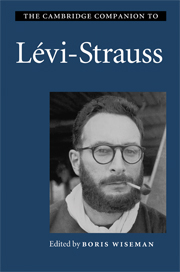Book contents
- Frontmatter
- Introduction
- Part I: Society and culture
- Part II: Myth and mind
- 5 The two natures of Lévi-Strauss
- 6 On anthropological knowledge
- 7 The limits of classification: Claude Lévi-Strauss and Mary Douglas
- 8 The local and the universal
- 9 Lévi-Strauss and the question of symbolism
- 10 Claude Lévi-Strauss’s theoretical and actual approaches to myth
- Part III: Language and alterity
- Part IV: Literature and aesthetics
- Bibliography of works by Claude Lévi-Strauss
- Index
7 - The limits of classification: Claude Lévi-Strauss and Mary Douglas
from Part II: - Myth and mind
Published online by Cambridge University Press: 28 January 2010
- Frontmatter
- Introduction
- Part I: Society and culture
- Part II: Myth and mind
- 5 The two natures of Lévi-Strauss
- 6 On anthropological knowledge
- 7 The limits of classification: Claude Lévi-Strauss and Mary Douglas
- 8 The local and the universal
- 9 Lévi-Strauss and the question of symbolism
- 10 Claude Lévi-Strauss’s theoretical and actual approaches to myth
- Part III: Language and alterity
- Part IV: Literature and aesthetics
- Bibliography of works by Claude Lévi-Strauss
- Index
Summary
Humans have to classify because they face situations of uncertainty. The problem of classifications is important for anthropology, because exotic societies classify objects in other ways than we do. When confronted with another society, the ethnographer feels that his/her systems of classifications are arbitrary, and that the criteria by which he/she links together objects in the world can be contested: a whale can be considered as a fish or as a mammal, depending on whether you focus on its mode of reproduction or its mode of locomotion. Classifications must then be seen not only as a way of describing the world as it is, but as a way of thinking about an environment on which it is necessary to act. This is why classifications are interesting not only for the anthropologist who wants to understand how other societies see the world, but also for the philosopher, who wants to know how human beings think.
Claude Lévi-Strauss's The Savage Mind, first published in 1962, is a book about classifications. After his works on kinship and before his works on myths, Lévi-Strauss takes 'a kind of pause . . . a break between two bursts of effort . . . to scan the scene before [him]' (1970: 9). When they trace genealogies of marriage and descent or when they tell stories of origins and conflicts, human beings always classify, they connect different beings of the world in a coherent framework. While the anthropologist is immersed in kinship systems or mythological transformations, the philosopher can take a step back and think reflexively on this human need to classify. How do humans classify, and why are their systems of classifications so diverse? What does classification reveal about the relation between thinking and the world?
- Type
- Chapter
- Information
- The Cambridge Companion to Lévi-Strauss , pp. 139 - 155Publisher: Cambridge University PressPrint publication year: 2009
- 1
- Cited by



